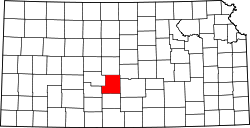19th century
The boundaries of Stafford County were defined by the Kansas Legislature of 1870 but for several years, the county remained unorganized. The Legislature of 1875, with the intention of obliterating the county from the map, gave the territory in Stafford County to other counties. They gave the portion in Range 15 West to Pawnee County; the portion included in Ranges 11, 12, 13 and 14 to Barton County; and the south half of the county, excepting the portion in Range 15, was added to Pratt County. But after each of the counties had taken its part, a strip six miles wide and twelve miles long (two townships) remained as Stafford County. This was the condition of the county until April 25, 1879, when, by a decision of the Supreme Court, the act of the Legislature dividing the county was declared unconstitutional and the county was restored to its original boundaries. [4] Stafford County was organized in 1879.
Amidst this legal turmoil, settlers began to establish themselves in the county. Among the earliest pioneers was W. R. Hoole, who in May 1874, laid claim to land in what would become Stafford County, followed by John Birbeck, who erected the county's first frame house shortly after and broke the first prairie in the county in 1875. The first child was born in the county in 1875, also to W. R. Hoole and his wife. A short-lived attempt at manufacturing salt at Salt Marsh, in the northeastern part of the county, was undertaken in 1876. The marsh was ultimately found to be better used as a pasture for livestock. [5]
In addition to individual settlers, a sizable Mormon settlement, known as Zion Valley, was established near St. John in the spring of 1875. Led by William Bickerton, this community established the county's first post office and erected a frame temple before internal disputes led to its dissolution and the temple's conversion into a commercial establishment. [5]
Educational infrastructure also began to take shape with the construction of the county's first schoolhouse, the Hoole Schoolhouse, in 1876, with Miss Ella Miller serving as its inaugural teacher. [5]
The early economy of Stafford County was heavily reliant on the gathering of buffalo bones, which were abundant across the region. This industry proved, however, to be short-lived, as the easily accessible bone deposits were quickly depleted. [5]





